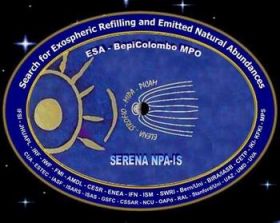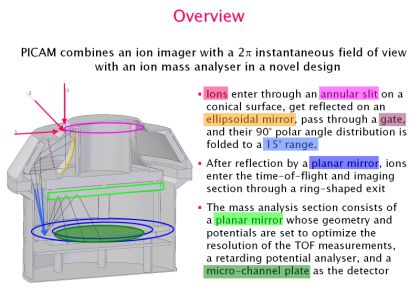
|
BepiColombo - SERENA
|
 |

|
BepiColombo - SERENA
|
 |

The SERENA instrument suite (Search for Exospheric Refilling and Emitted Natural Abundances) will study in-situ the composition, the vertical structure and the source of the deposit processes of the exosphere of Mercury.
The SERENA consortium is led by the Principal Investigator S. Orsini from IFSI, Rome, Italy.
|
|
The Instruments |
|||
|
|
MPS contribution
|
|||
|
|
Science Objectives |
|||
|
|
Collaboration |
|||
|
|
Technical Data |
|||
|
|
Electronic Block Diagram |
|||
|
|
The Team |
|||
|
|
Related links |
|||
|
BepiColombo publications by MPS members |
The main contribution by MPS to SERENA will be scientific support for the experiment and the High Voltage Power Supply for the PICAM sensor. This includes the 'gating' of incoming ions using an algorithm based on probability theory (Hadamard algorithm) implemented in a field programmable array (FPGA) within the HV-unit. Thus we here only describe details of the PICAM sensor. The MPS contribution is supported by the German Government through the German Space Agency (DLR) under contract 50 QW 0503 and by the Max Planck Society.
 PICAM is one of the four sensors belonging to the
PICAM is one of the four sensors belonging to the ![]() SERENA instrument suite.
SERENA instrument suite.
One of the major questions to be investigated by the BepiColombo mission is the role and efficiency of the surface of Mercury as a source of exospheric neutrals and magnetospheric ions. By measuring ions at relatively low energies, i.e. from thermals up to a few keV, PICAM will offer the possibility to get information on the soil composition, on the rate of neutral escape from the surface, on the efficiency of the various source locations as well as on the physical processes that act to eject the neutrals from the surface. The main objectives of PICAM are listed as follows:
PICAM is developed within the SERENA consortium in a collaboration of
The PICAM (Planetary Ion CAMera) ion mass spectrometer operates as an all-sky camera for charged particles allowing the determination of the velocity distribution and mass spectrum for ions over a full 2π field of view (FOV), from thermal up to ~3 keV energies and in a mass range extending up to ~132 amu (Xenon). An instantaneous 2π FOV coupled with this mass range and a mass resolution better than ~100 result in a superior performance.
| Energy range | 1 eV - 3 keV |
|---|---|
| Energy resolution ΔE/E | 10-50% (controllable) |
| Viewing angle | 2.17 π |
| Angular resolution | 6 - 10 deg (controllable) |
| Mass resolution m/Δm | >100 |
| Optimal temporal resolution | 10 sec |
| Geometric factor G | 0.021 cm2 ster |
| Instrument total mass | 1343g |
| Power consumption | 3.1-7.0 W |
| Data rate | 0.5-3.0 kbit/s |
| Joachim Woch | Co-Investigator |
| Markus Fraenz | Scientist |
| Norbert Krupp | Co-Investigator |
| Alexander Loose | Electronics Engineer |
| Henning Fischer | Electronics Engineer |
| Ulrich Bührke | Technician |
|
SERENA homepage at IFSI, Rome |
|
|
PICAM homepage at IWF,Graz |
| © 2006, Max Planck Institute for Solar System Research, Lindau |
Markus Fränz 30-08-2007 |